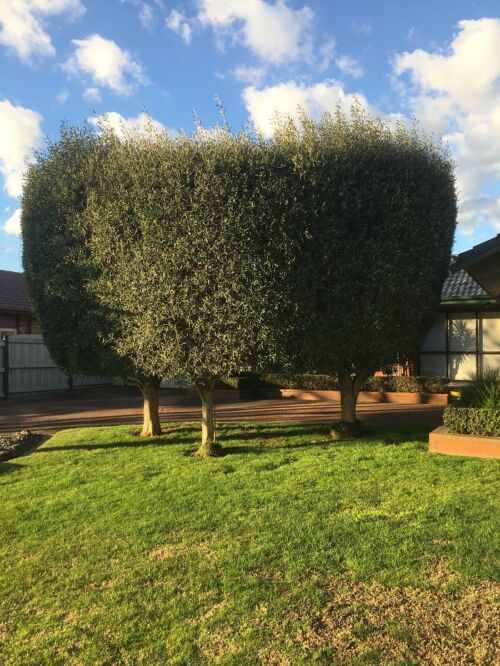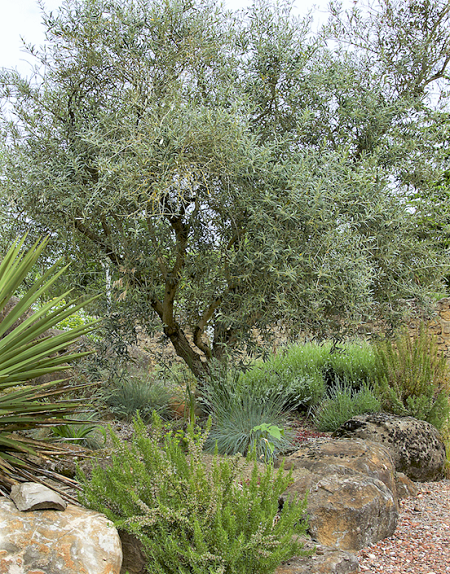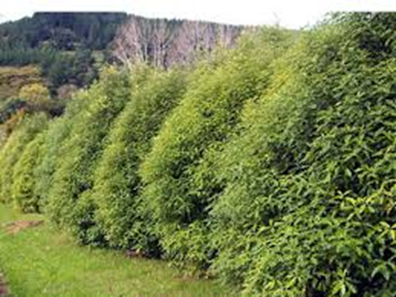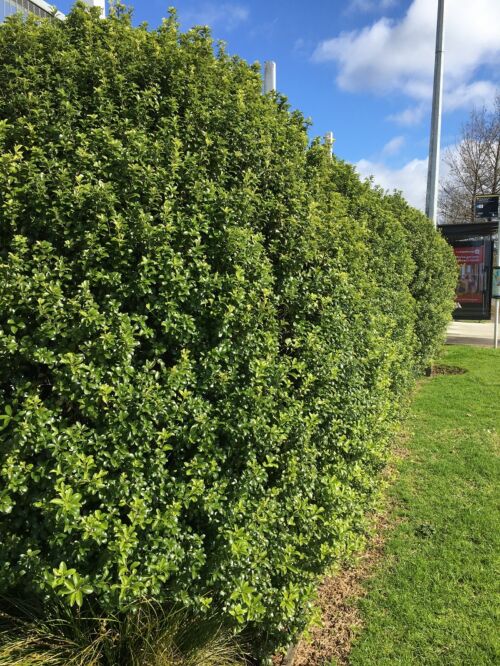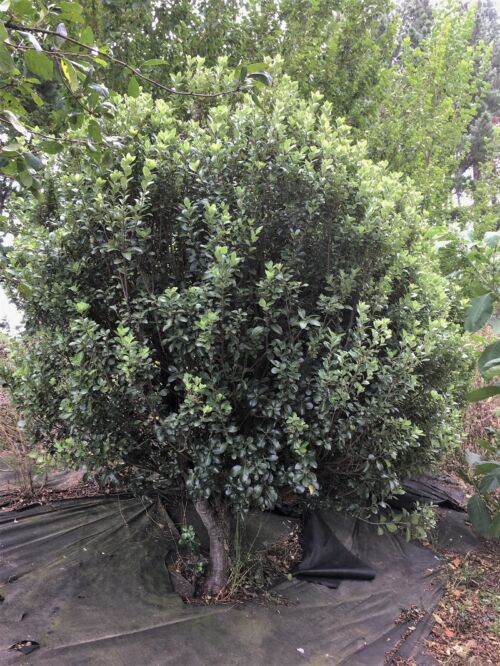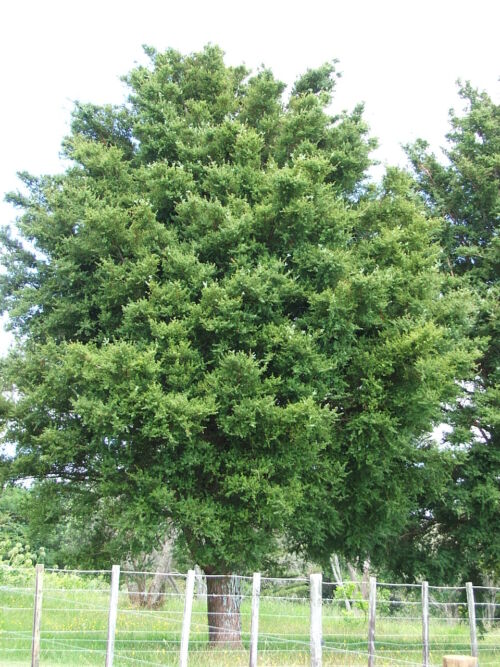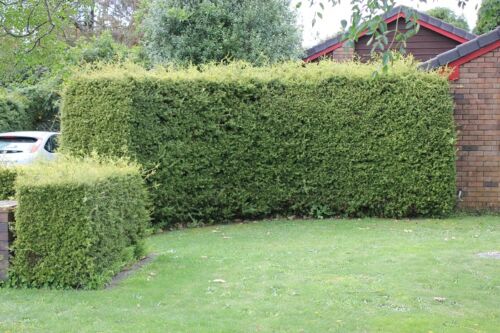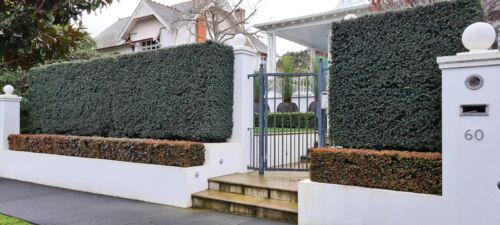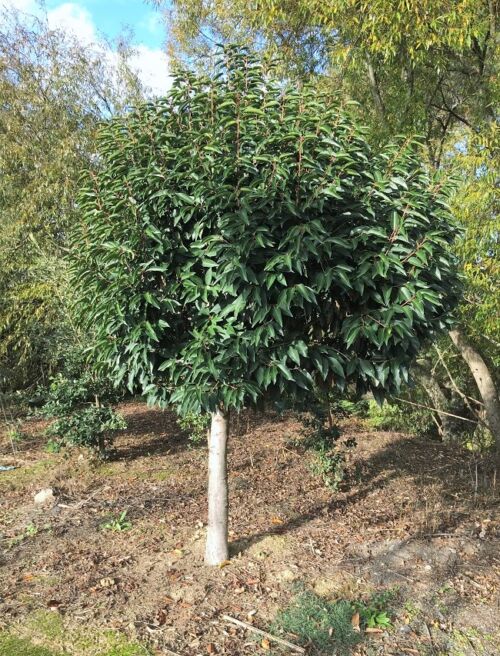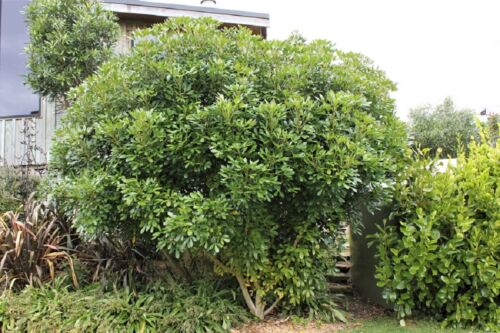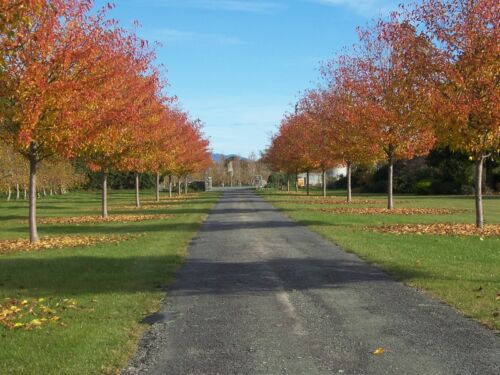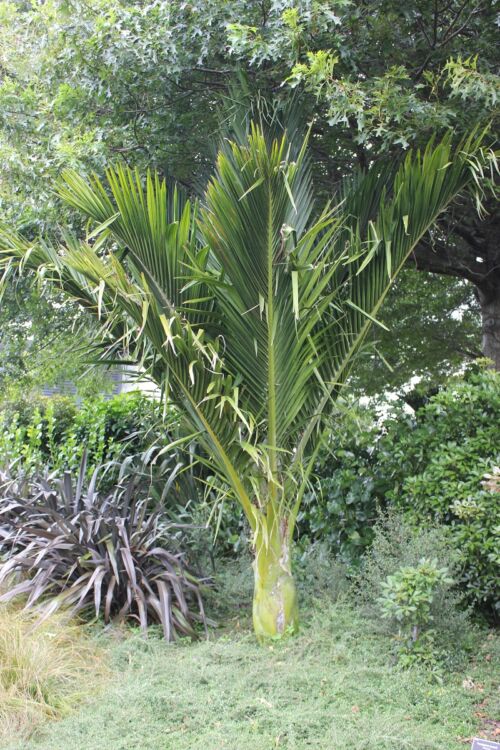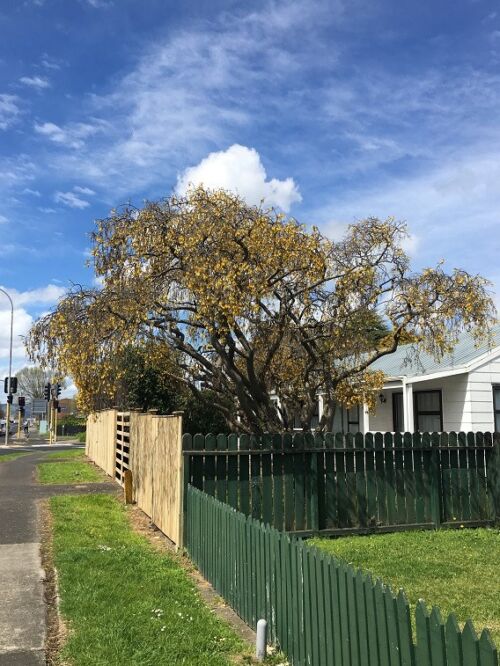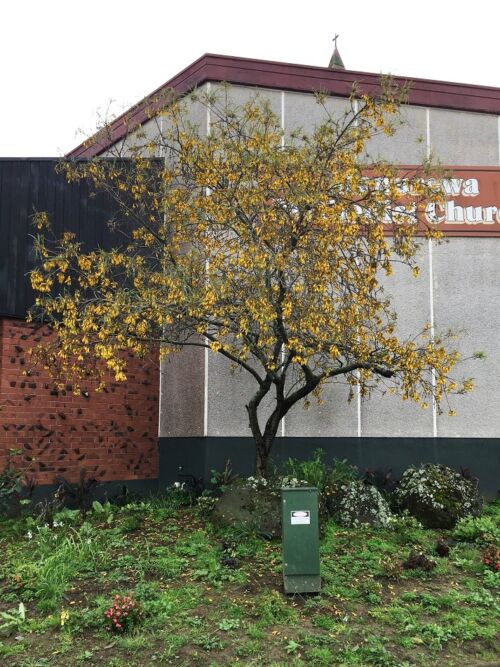Bird Feeding Trees
-
- Description
A compact Olive with smaller leaves giving a dense appearance. A consistent small fruiting variety with heavy crops. Has a good oil content and also used for pickling. Being from the Mediterranean olive trees require full sun and will tolerate wind coastal and can also survive extended dry periods. This variety especially good for hedging as it trims well into a dense hedge. Height x Width 4 x 2 Range Small 1-5m Growth Rate Moderate Plant Type Tree Shape Conical Country of Origin Greece Similar to Consider Syzygium resilience, Michelia Figo, Camellias, Pittosporums, Corokia, Griselinia, Ficus, Ilex largo, Eugenia Ventinatii - Leaf
Leaf Colour Green - Flower
Flower Colour Cream very small Fragrant? No - Uses
Accent Yes Screening Yes Hedging Yes Bird Feeding Yes Fruit Producing Yes but small Note: Growth, height and grade information are given in good faith but are subject to natural variables beyond our control. -
- Description
Olea europaea means 'European olive' in Latin and is what we commonly call “The Olive”. Normally grow as a small tree or shrub, and are found traditionally in the Mediterranean Basin. The species is cultivated in all the countries of the Mediterranean, as well as in Australia, New Zealand, North and South America and South Africa. The olive's fruit is grown primarily for oil, eating, or both. The trees is also suitable tree for standardising. Being from the Mediterranean olive trees require full sun and will tolerate wind coastal and can also survive extended dry periods. Grows apx 6 x 3m. Make enquiries as to which varieties we have available now or see our online catalogue. Height x Width 6 x 3 Height Range Medium 5-10m Growth Rate Fast Plant Type Tree Shape Round Country of Origin Mediterranean Similar to Consider Other Olives - Leaf
Leaf Colour Green Olive - Flower
Flower Colour Cream very small Fragrant? No - Uses
Good Shade Tree? Yes Screening / Shelter Yes Bird Feeding Yes Fruit Producing Yes Note: Growth, height and grade information are given in good faith but are subject to natural variables beyond our control. -
- Description
Hardy coastal large shrub or small tree. Leathery dark green leaves felted underneath. Flowers dark crimson to purple. Prefers full sun in free draining soil but will also tolerate dry soil once established. Easily trims to make a very good hedge or can be allowed to grow to a hardy screen. Windy conditions and coastal exposure OK. Height x Width 6 x 4 Range Medium 5-10m Growth Rate Moderate Plant Type Tree Shape Round Country of Origin New Zealand Similar to Consider Syzygium resilience, Michelia Figo, Camellias, Corokia, Griselinia, Ficus, Ilex largo, Olea El Greco, Eugenia Ventinatii - Leaf
Leaf Colour Green - Flower
Flower Colour Purple Fragrant? No - Uses
Screening / Shelter Yes Hedging Yes Bird Feeding Yes Fruit Producing No Note: Growth, height and grade information are given in good faith but are subject to natural variables beyond our control. -
- Description
A fast-growing bushy native tree. Leaves larger than other pittosporums and has lemon scent when crushed. It has highly fragrant clusters of small attractive yellow-cream flowers in spring, followed by distinctive black seed capsules. Best in full sun. Will tolerate damp soils and moderately windy conditions. Ideal as a large screen or hedge as responds very well to trimming. Plant Type Tree Shape Pyramidical Country of Origin New Zealand Similar to Consider Other Pittosporums, Planchonella costata, Myrsine salicina - Leaf
Leaf Colour Green Lime - Flower
Flower Colour Yellow - small Fragrant? Yes - Uses
Screening / Shelter Yes Bird Feeding Yes Hedging Yes Note: Growth, height and grade information are given in good faith but are subject to natural variables beyond our control. -
- Description
Tenufolium type: Compact bushy small tree with an excellent rounded habit. Leaves lettuce green small and fresh-looking. Small purple flowers are fragrant in the stillness or morning or evening. Full sun dry tolerant once established. Trims well so ideal as a hedge planted in rows or individually as a specimen. Height x Width 3 x 3 Range Small 1-5m Growth Rate Moderate Plant Type Tree Shape Round Country of Origin New Zealand Similar to Consider Other Pittosporums - Leaf
Leaf Colour Green Lime - Flower
Flower Colour Red Purple Fragrant? No - Uses
Screening / Shelter Yes Hedging Yes Bird Feeding Yes Note: Growth, height and grade information are given in good faith but are subject to natural variables beyond our control. -
- Description
This plant has a tidy habit with and upright medium form. The foliage is smooth with a slight grey/green appearance and attractive pointed leaves. Compact and useful for hedging and screening. Small purple fragrant flowers. Good for coastal conditions being from the windy Stephen’s Island in the middle of the Cook Strait. Responds very well to trimming. Height x Width 4 x 2 Height Range Small 1-5m Growth Rate Moderate Plant Type Shrub Shape Round Country of Origin New Zealand Similar to Consider Other Pittosporums - Leaf
Leaf Colour Dark Green - Flower
Flower Colour Purple Fragrant? Yes - Uses
Screening / Shelter Yes Hedging Yes Bird Feeding Yes Note: Growth, height and grade information are given in good faith but are subject to natural variables beyond our control. -
- Description
The parent plant of many cultivars which have been produced from the variations of seed grown plants. A fast growing, slender tree with erect narrow pyramidal form. Full sun dry tolerant once established. Easily trimmed to shape so ideal as a hedge or screen. Sweetly scented small purple flowers in Spring. Height x Width 5 x 3 Height Range Medium 5-10m Growth Rate Moderate Plant Type Tree Shape / Habit Round Country of Origin New Zealand Similar to Consider Other Pittosporums - Leaf
Leaf Colour Green - Flower
Flower Colour Purple Fragrant? Yes - Uses
Good Shade Tree? Yes Screening / Shelter Yes Hedging Yes Bird Feeding Yes Note: Growth, height and grade information are given in good faith but are subject to natural variables beyond our control. -
- Description
A small growing coastal tree with glossy dark green leaves. Small delicate light green flowers followed by 25mm green fruit changing to purple-black when ripe which wood pigeon love. Can be trimmed to keep shape and bushiness. Height x Width 6 x 3 Range Medium 5-10m Growth Rate Moderate Plant Type Tree Shape Round Country of Origin New Zealand Similar to Consider Myrsine salicina, Dodonea Viscosa and Purp, Alectryon excelsa, Vitex Lucens, Dysoxylum Spectabile, - Leaf
Leaf Colour Green - Flower
Flower Colour Light green - small Fragrant? No - Uses
Screening / Shelter Yes Bird Feeding Yes Note: Growth, height and grade information are given in good faith but are subject to natural variables beyond our control. -
- Description
Hardy slow growing form with dull bronzy green stiff narrow leaves to 25mm with a sharp point. Stout trunk with rough reddish-brown bark. Once established will withstand drought. Excellent specimen tree or can be used for screening or trimmed into hedging. Height x Width 15 x 8 Height Range Tall 10m+ Growth Rate Slow Plant Type Tree Shape Round Country of Origin New Zealand Similar to Consider Matapouri Blue, Green Form - Leaf
Leaf Colour Brown Green - Flower
Flower Insignificant - Uses
Specimen Yes Accent Yes Screening / Shelter Yes Bird Feeding Yes Note: Growth, height and grade information are given in good faith but are subject to natural variables beyond our control. -
- Description
A more upright, very bushy growing variety of our NZ Totara. Strong, slow growing, bushy from an early age, ideal for hedging or where space is more limited. Grows to Apx 8m Height x Width 8 x 3m Height Range Medium 5-10m Growth Rate Moderate Plant Type Tree Shape / Habit Upright, Bushy Country of Origin New Zealand Similar to Consider Totara, Matapouri Blue, Podocarpus gracillis - Leaf
Leaf Colour Green - Flower
Flower Insignificant - Uses
Screening / Shelter Yes Hedging Yes Bird Feeding Yes Note: Growth, height and grade information are given in good faith but are subject to natural variables beyond our control. -
- Description
A brilliant compact selection of our native totara with small blue-grey foliage. Has a more upright pyramidical habit. Its slow growth makes it easy to manage in any sized garden. Excellent as a specimen tree or planted as a hedge. Height x Width 7 x 5 Height Range Medium 5-10m Growth Rate Slow Plant Type Tree Shape Conical Country of Origin New Zealand Similar to Consider Podocarpus Totara and Black Bridge. Podocarpus gracilis - Leaf
Leaf Colour Glaucus Blue - Flower
Flower Insignificant - Uses
Specimen Yes Accent Yes Screening / Shelter Yes Hedging Yes Bird Feeding Yes Note: Growth, height and grade information are given in good faith but are subject to natural variables beyond our control. -
- Description
Large evergreen shrub or small tree dark glossy green oval leaves. Dull white hawthorn scented flowers in slender racemes late spring/summer followed by fruits. Moist to dry conditions but will not tolerate wet feet. Excellent for hedges or Topiary or can be allowed to grow as a screen Height x Width 5 x 4 Height Range Medium 5-10m Growth Rate Moderate Plant Type Tree Shape Conical Country of Origin Western Europe, France, Spain Portugal, Morocco Similar to Consider Camellias, Laurus Nobilis, Michelia Figo, Syzygium resilience, Pittosporums, Corokia, Griselinia, Ficus, Ilex largo, Olea El Greco, Eugenia Ventinatii - Leaf
Leaf Colour Dark Green - Flower
Flower Colour White Fragrant? Yes - Uses
Specimen Yes Accent Yes Hedging Yes Note: Growth, height and grade information are given in good faith but are subject to natural variables beyond our control. -
- Description
A fast growing much-branched, rich deep green foliaged shrub, with three or five thick, leathery leaflets to each stem. Windy sites Ok. Good for coastal planting. Trims well for a hedgerow or wind break. Does not like wet feet. NZ Native. ALSO: Pseudopanax Lessonii Purpurea with Black Purple leaves Height x Width 4 x 2.5 Height Range Small 1-5m Growth Rate Moderate Plant Type Shrub Shape Round Country of Origin New Zealand Similar to Consider P. Cyril Watson, P. Laetus, Griselinia Broadway Mint, Griselinia Lucida, Planchonella costata, Ilex Largo - Leaf
Leaf Colour Green - Flower
Flower Insignificant - Uses
Screening / Shelter Yes Hedging Yes Bird Feeding Yes Note: Growth, height and grade information are given in good faith but are subject to natural variables beyond our control. -
- Description
Pyramidal growing tree with glossy green leaves over summer turning striking red in autumn. Profusion of white flowers in early spring. A more upright habit. Tolerant of poor drainage. Apx 7 x 4m ALSO AVAILABLE: Bradford is similar. Kea is a smaller grower Height x Width 7 x 4 Height Range Medium 5-10m Growth Rate Fast Plant Type Tree Shape Round Country of Origin China Similar to Consider Liquidambars, Acer rubrum types, Quercus coccinea or rubra, Amelanchier Canadensis, Nyssa Sylvatica - Leaf
Leaf Colour Green Deciduous Leaf Colour Red - Flower
Flower Colour White Fragrant? No - Uses
Specimen Yes Good Shade Tree? Yes Accent Yes Bird Feeding Yes Note: Growth, height and grade information are given in good faith but are subject to natural variables beyond our control. -
- Description
From Kermadec Is. group this Nikau has broader fronds with each leaflet slightly spaced apart. It is also more tolerant to exposed conditions than the NZ Nikau. After some years a trunk forms which is scarred with rings from old fallen leaves. Prefers a shady position when young but will tolerate full sun, wind and coastal conditions. Prefers a cool root run. An excellent garden specimen or potted plant. Slow growing. Height x Width 10 Height Range Medium 5-10m Growth Rate Moderate Plant Type Palm Shape Palm Country of Origin New Zealand Similar to Consider Sapida, Pittii - Leaf
Leaf Colour Dark Green - Flower
Flower Colour White, very small Fragrant? No - Uses
Specimen Yes Accent Yes Bird Feeding Yes Note: Growth, height and grade information are given in good faith but are subject to natural variables beyond our control. -
- Description
Nikau from the Southern Chatham Islands. They differ from the mainland species with longer fronds, wider leaflets, a silvery hue to them stems and larger fruit. Will tolerate full sun, high wind, cold and coastal conditions. Generally, a much tidier variety. Height x Width 10 Height Range Medium 5-10m Growth Rate Slow Plant Type Palm Shape Palm Country of Origin New Zealand Similar to Consider Sapida, Cheesemanii - Leaf
Leaf Colour Dark Green - Flower
Flower Colour White, very small Fragrant? No - Uses
Specimen Yes Accent Yes Bird Feeding Yes Note: Growth, height and grade information are given in good faith but are subject to natural variables beyond our control. -
- Description
New Zealand’s only native palm is elegant and graceful with straight slender smooth stems crowned with fan-like rich green leaves up to 3m long. After some years a trunk forms which is scarred with rings from old fallen leaves. Prefers a cool root run. Prefers a shady position when young. At maturity will tolerate full sun, wind and coastal conditions. An excellent garden specimen or potted plant. Slow growing. Over many years can reach 10m. Plant Type Palm Shape Palm Country of Origin New Zealand Similar to Consider Pittii, Cheesemanii - Leaf
Leaf Colour Dark Green - Flower
Flower Colour White, very small Fragrant? No - Uses
Specimen Yes Accent Yes Bird Feeding Yes Note: Growth, height and grade information are given in good faith but are subject to natural variables beyond our control. -
- Description
The coastal kowhai is distinguished from all other Kowhai species by the absence of a divaricating juvenile stage. Leaves are slightly larger than microphylla. Primarily a species of the coastal forest, often on cliff faces or banks overlooking estuarine rivers or inlets. This species was once included as Sophora microphylla. Yellow flowers from late winter to spring. Height x Width 6 x 4m Height Range Medium 5-10m Growth Rate Moderate Plant Type Tree Shape Spreading Country of Origin New Zealand Similar to Consider S. Microphylla, S.Tetraptera - Leaf
Leaf Colour Green - Flower
Flower Colour Yellow Fragrant? No - Uses
Specimen Yes Good Shade Tree? Yes Bird Feeding Yes Note: Growth, height and grade information are given in good faith but are subject to natural variables beyond our control. -
- Description
Widespread NZ native species. Small green pinnate leaflets. Golden-yellow, tubular 45mm flowers in pendulous racemes, en-masse during spring. Attracts native birds. Excellent small garden specimen. Height x Width 5.0 x 2.5 Height Range Small 1-5m Growth Rate Moderate Plant Type Tree Shape Round Country of Origin New Zealand Similar to Consider Sophora Dragons Gold, Chathamica, Tetraptera - Leaf
Leaf Colour Green - Flower
Flower Colour Yellow Fragrant? No - Uses
Accent Yes Bird Feeding Yes Note: Growth, height and grade information are given in good faith but are subject to natural variables beyond our control. -
- Description
Slightly larger growing tree than S. microphylla with weeping branches. Larger leaves than microphylla at 8-16cm. Does not have the tangled juvenile growth. Golden yellow flowers in spring in racemes commence earlier than Microphylla. A more open airy habit. A spectacular sight in full bloom. Attracts native birds. Height x Width 7 x 4 Range Medium 5-10m Growth Rate Moderate Plant Type Tree Shape Spreading Country of Origin New Zealand Similar to Consider Sophora Microphylla, Chathamica - Leaf
Leaf Colour Green - Flower
Flower Colour Yellow Fragrant? No - Uses
Specimen Yes Good Shade Tree? Yes Accent Yes Bird Feeding Yes Note: Growth, height and grade information are given in good faith but are subject to natural variables beyond our control.

